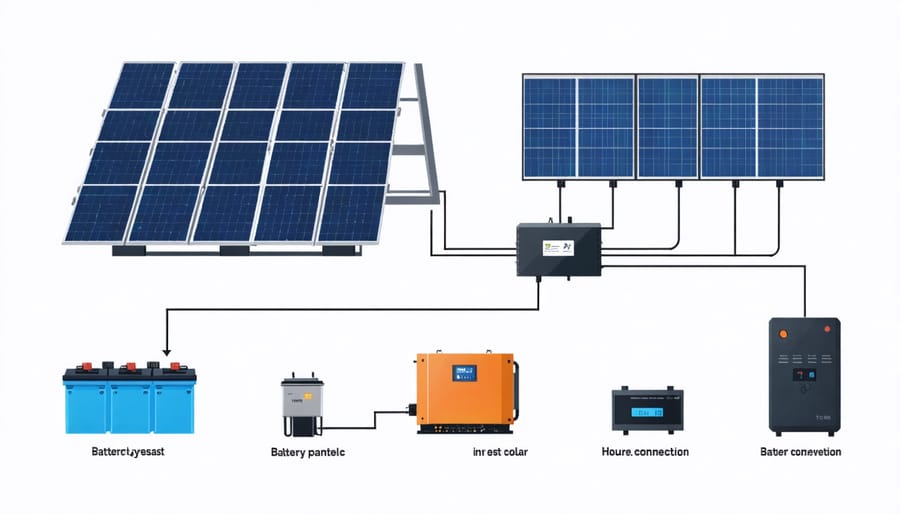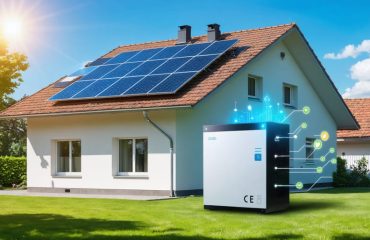Solar battery backup systems revolutionize home energy independence by capturing excess solar power and storing it for when you need it most. These intelligent systems seamlessly integrate with your existing solar panels to power your home 24/7, even during grid outages or nighttime hours. Acting as your personal energy bank, they automatically detect power failures, switch to stored power within milliseconds, and maintain your essential household operations without interruption.
Think of a solar battery backup as your home’s energy insurance policy – collecting solar energy during peak production hours and dispensing it precisely when conventional power becomes unavailable or expensive. This sustainable solution not only provides peace of mind during outages but also helps reduce electricity bills by allowing you to use your own stored energy instead of drawing from the grid during high-rate periods.
Modern solar battery systems have transformed from simple storage devices into sophisticated energy management solutions that optimize your home’s power consumption, maximize solar investment returns, and provide a reliable pathway to energy independence. Whether you’re looking to protect against power outages, reduce your carbon footprint, or take control of your energy costs, understanding how these systems work is the first step toward a more resilient and sustainable home.

The Core Components of a Solar Battery Backup System
Solar Panels and Energy Generation
Solar panels work by converting sunlight into electricity through photovoltaic cells. When sunlight hits these cells, it creates an electric field that generates direct current (DC) electricity. This process happens silently and continuously during daylight hours, making solar panels a reliable source of clean energy for your home.
The panels, typically installed on your roof or in a sunny area of your property, are connected to an inverter that converts the DC electricity into alternating current (AC) power – the type of electricity your home appliances use. During peak sunlight hours, your solar panels often generate more electricity than your home needs at that moment.
This excess energy doesn’t go to waste. Instead of sending it back to the grid, your solar battery backup system captures and stores this surplus power. The system’s charge controller ensures the batteries are charged safely and efficiently, preventing overcharging while maximizing storage capacity. This stored energy becomes your backup power source, ready to keep your lights on and appliances running when the sun isn’t shining or during power outages.
Battery Storage Units
Modern solar backup systems utilize various types of solar batteries, each offering unique advantages for home energy storage. The most popular option is lithium-ion batteries, which provide excellent energy density, longer lifespan, and minimal maintenance requirements. These batteries typically store between 10-15 kilowatt-hours of energy, enough to power an average home for 24-48 hours.
Lead-acid batteries, while more affordable, offer a reliable alternative with proven technology, though they require more maintenance and have a shorter lifespan. For larger storage needs, saltwater batteries are emerging as an eco-friendly option, capable of storing significant amounts of energy without using toxic materials.
Most modern battery units come with smart monitoring systems that help optimize energy usage and protect the batteries from overcharging or excessive discharge. They’re designed to be compact, often wall-mounted or stored in your garage, and can be easily expanded by adding more units as your energy needs grow. The best part? These systems automatically switch on during power outages, ensuring your home stays powered without any manual intervention.
Inverters and Control Systems
Inverters play a crucial role in your solar battery backup system by converting the DC power stored in batteries into AC power that your home appliances can use. These smart devices act as the system’s brain, automatically managing power flow between your solar panels, batteries, and home. Modern inverters include sophisticated monitoring and control systems that help optimize energy usage and battery life. They seamlessly switch between power sources when needed, ensuring your home stays powered during outages. Many inverters also connect to smartphone apps, letting you track energy production, storage, and consumption in real-time. This gives you complete control over your home’s energy management while maximizing the benefits of your solar investment.
How Solar Battery Backup Systems Function
Daytime Operation
During daylight hours, your solar battery backup system operates at its peak efficiency, working seamlessly to power your home and store excess energy. Solar panels capture sunlight and convert it into electricity, which first flows through an inverter to transform it into usable AC power for your home. This clean energy directly powers your appliances and devices, reducing your reliance on grid electricity.
What makes the daytime operation truly smart is its priority system. When your solar panels generate more electricity than your home needs, instead of sending that surplus back to the grid, the excess power charges your battery storage system. This stored energy becomes your backup power source for nights, cloudy days, or grid outages.
The system’s charge controller manages this process automatically, ensuring your batteries are charged efficiently without overloading. You can monitor this operation through a user-friendly app, which shows you real-time energy production, consumption, and battery charge levels.
Think of it like filling a water tank during rainy season – you’re collecting resources when they’re abundant to use them when needed. This daytime charging cycle not only provides energy security but also maximizes your solar investment by ensuring no generated power goes to waste. The system continuously adjusts its operation based on your home’s energy needs, weather conditions, and battery charge status, all without requiring any input from you.

Nighttime and Cloud Coverage
One of the most common questions about solar battery backup systems is how they handle nighttime and cloudy conditions. The good news is that these systems are designed to keep your home powered even when the sun isn’t shining. During daylight hours, your solar panels typically generate more electricity than you need, storing this excess energy in your battery system for later use.
When clouds roll in or night falls, your home automatically draws power from the stored energy in your batteries instead of the solar panels. Modern battery systems are sophisticated enough to seamlessly switch between power sources without any interruption to your home’s electricity supply. Most residential battery systems can store enough energy to power essential appliances and lights for 24-48 hours, depending on your energy consumption.
On particularly cloudy days when solar production is limited, your system can also draw power from the grid to ensure your batteries maintain a healthy charge level. This hybrid approach means you’re never left in the dark, even during extended periods of poor weather. The system’s smart controller manages this process automatically, optimizing when to store, use, or supplement your solar power to maintain consistent energy availability.
For maximum efficiency, many homeowners choose to prioritize essential appliances and systems during nighttime hours, ensuring their stored energy lasts longer when it’s needed most.
Grid Outage Response
When the power grid goes down, your solar battery backup system springs into action seamlessly, often so quickly you might not even notice the transition. This automatic response is managed by a smart transfer switch, which constantly monitors your home’s connection to the grid. The moment it detects a power outage, it disconnects your home from the grid and activates your backup power system in a fraction of a second.
During an outage, your system prioritizes powering essential appliances and circuits you’ve pre-selected during installation. This might include your refrigerator, lighting, medical equipment, and security systems. The battery inverter converts the stored DC power from your batteries into the AC power your home needs, ensuring a steady supply of electricity.
What makes this system particularly reliable is its ability to continue charging your batteries during daylight hours, even during an extended outage. Your solar panels keep generating electricity, which can either power your home directly or recharge your batteries for nighttime use. This self-sustaining cycle means you can maintain power independence for days or even weeks, depending on your battery capacity and energy usage.
Your system will automatically switch back to grid power once service is restored, ensuring a smooth transition without any action required on your part. This hands-free operation provides peace of mind, knowing your home will stay powered through whatever challenges arise.
Real Benefits for Homeowners
Energy Independence
Solar battery backup systems offer true energy independence by freeing homeowners from complete reliance on the power grid. When you generate and store your own solar power, you maintain control over your energy supply, regardless of grid outages or utility company decisions. During the day, your solar panels produce electricity that not only powers your home but also charges your battery system. This stored energy becomes your personal power reserve, ready to kick in automatically when needed.
This independence means you can keep your lights on, appliances running, and essential systems working even during blackouts. Unlike traditional grid-tied solar systems that shut down during power outages, battery backup systems continue providing electricity seamlessly. You’ll no longer have to worry about storm-related outages, grid maintenance, or peak demand periods affecting your power supply.
Additionally, energy independence through battery backup can protect you from rising utility rates and time-of-use pricing. By using stored solar energy during peak rate periods, you maintain consistent energy costs while reducing your carbon footprint. It’s like having your own mini power plant, giving you both security and peace of mind.
Cost Savings Over Time
Installing a solar battery backup system is a smart financial decision that pays dividends over time. While the initial investment may seem substantial, homeowners typically see significant cost savings within the first few years of operation. By storing excess solar energy for later use, you can maximize your solar investment and reduce your reliance on grid power during peak rate periods.
Most households see a 40-80% reduction in their monthly utility bills after installing a solar battery system. This saving potential increases in areas with time-of-use pricing, where electricity costs more during peak hours. By drawing from your stored energy during these expensive periods, you can avoid the highest utility rates.
The financial benefits extend beyond daily savings. Many utility companies offer net metering programs, allowing you to earn credits for excess energy you send back to the grid. Additionally, solar battery systems can protect you from rising electricity costs, which historically increase by about 2-3% annually.
The system’s longevity also contributes to its cost-effectiveness. Modern solar batteries typically last 10-15 years, and many manufacturers offer warranties that guarantee performance throughout this period. When combined with available tax incentives and rebates, most homeowners recover their initial investment within 5-7 years, enjoying free stored energy for the remainder of the system’s life.

Environmental Impact
Solar battery backup systems offer significant environmental benefits by reducing your carbon footprint and promoting sustainable living. When you store and use solar energy, you decrease your reliance on fossil fuel-generated electricity from the grid, directly lowering greenhouse gas emissions. A typical home solar battery system can prevent several tons of carbon dioxide emissions annually – equivalent to taking a car off the road for months.
These systems also support the broader adoption of renewable energy by helping to balance the electrical grid. When many homeowners use battery storage, it reduces the need for environmentally harmful “peaker plants” that normally kick in during high-demand periods. Additionally, solar batteries extend the environmental benefits of your solar panels by ensuring that virtually no clean energy goes to waste.
The manufacturing process of solar batteries continues to become more sustainable, with many manufacturers implementing recycling programs and using eco-friendly materials. By choosing a solar battery backup system, you’re not just investing in your home’s energy independence – you’re contributing to a cleaner, more sustainable future for generations to come.
Solar battery backup systems represent a significant step forward in home energy independence and sustainability. By combining solar power generation with energy storage capabilities, these systems offer homeowners a reliable solution for maintaining power during outages while reducing their carbon footprint and electricity bills.
The benefits of installing a solar battery backup system extend far beyond emergency power. Homeowners can expect to see substantial savings on their monthly energy bills, especially during peak rate hours when electricity costs are highest. Additionally, many states offer tax incentives and rebates for installing these systems, making the initial investment more affordable than ever.
For those considering a solar battery backup system, the next steps are straightforward. Start by conducting an energy audit of your home to understand your power needs and consumption patterns. This information will help determine the appropriate system size and battery capacity for your specific situation. Next, research and contact several certified solar installers in your area to obtain quotes and system recommendations.
During the consultation process, be sure to ask about:
– System sizing and scalability options
– Battery life expectancy and warranty terms
– Installation timeline and requirements
– Available tax incentives and rebates
– Maintenance requirements and costs
– Monitoring capabilities and smart features
Remember that while the upfront cost may seem significant, the long-term benefits of energy independence, reduced utility bills, and environmental impact make solar battery backup systems a worthwhile investment for many homeowners. As technology continues to advance and prices decrease, these systems are becoming increasingly accessible to the average homeowner.
Take the first step toward energy independence by scheduling consultations with local solar installers. With proper planning and professional installation, you can join the growing number of homeowners enjoying the security and savings that come with solar battery backup systems.









